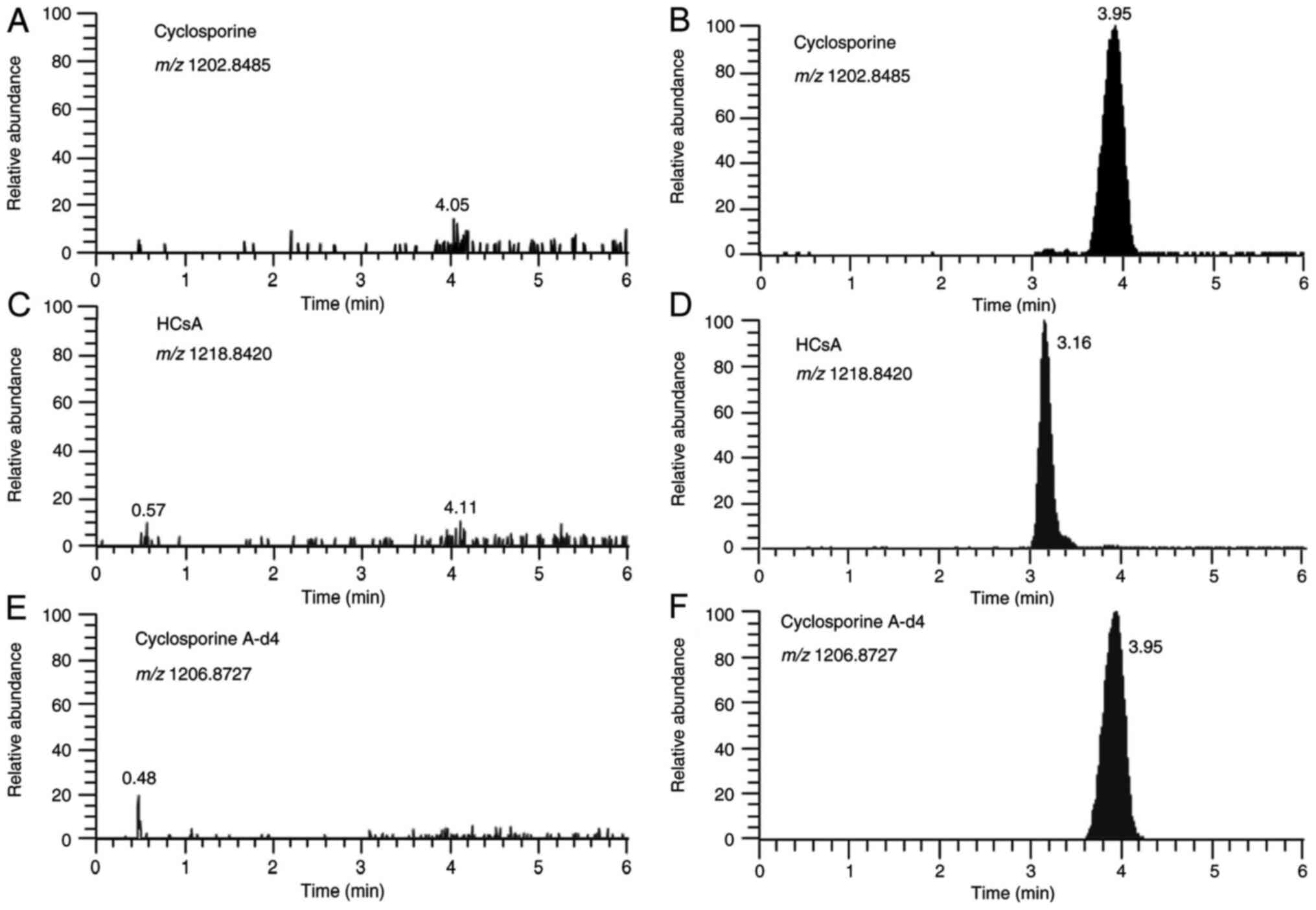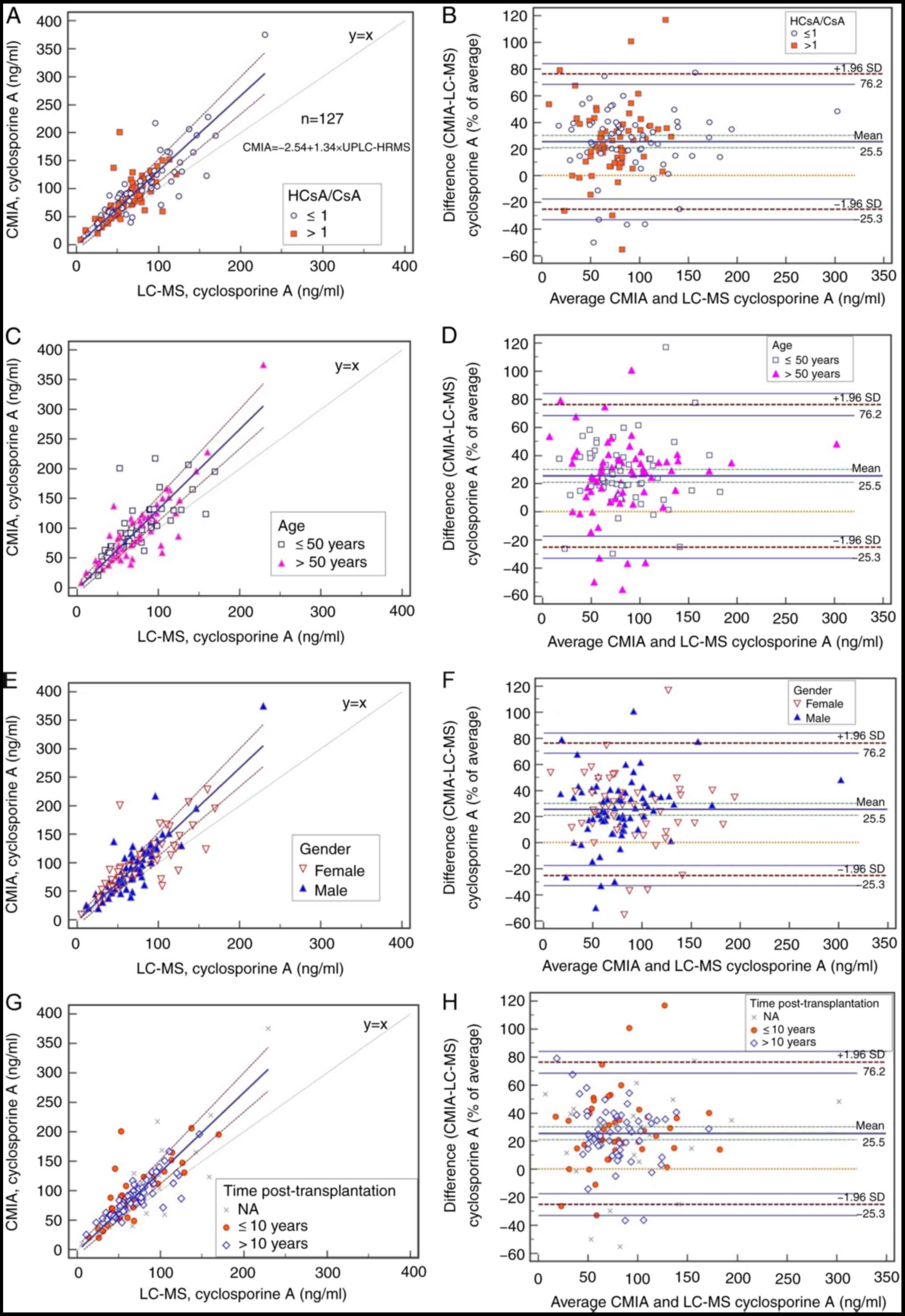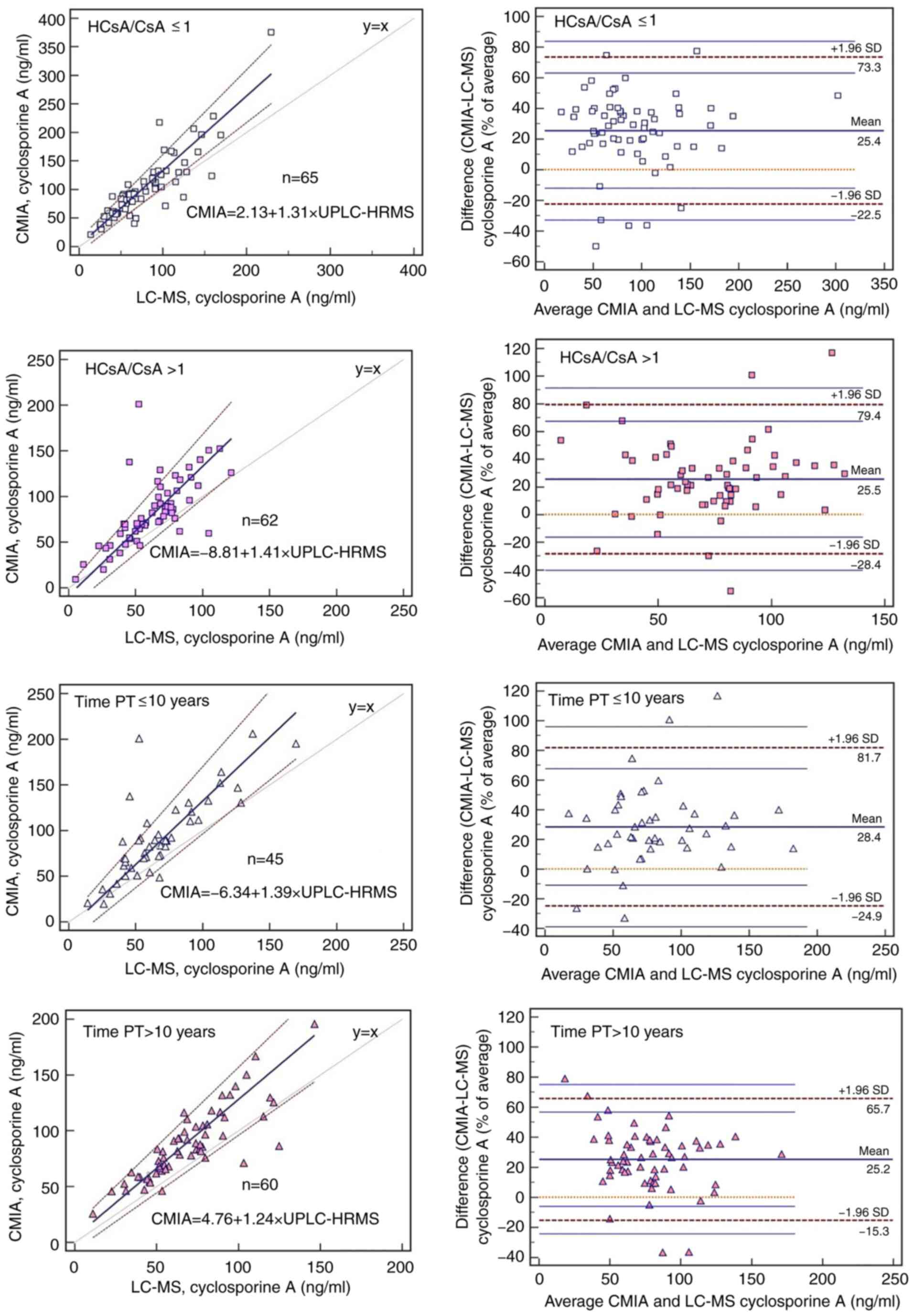|
1
|
Hajkova M, Jaburek F, Porubska B, Bohacova
P, Holan V and Krulova M: Cyclosporine a promotes the therapeutic
effect of mesenchymal stem cells on transplantation reaction. Clin
Sci (Lond). 133:2143–2157. 2019.PubMed/NCBI View Article : Google Scholar
|
|
2
|
Kurata Y, Kuzuya T, Miwa Y, Iwasaki K,
Haneda M, Amioka K, Yamada K, Watarai Y, Katayama A, Uchida K and
Kobayashi T: Clinical relevance of post-transplant pharmacodynamic
analysis of cyclosporine in renal transplantation. Int
Immunopharmacol. 22:384–391. 2014.PubMed/NCBI View Article : Google Scholar
|
|
3
|
Hryniewiecka E, Żegarska J, Żochowska D,
Jaźwiec R, Borowiec A, Samborowska E, Tszyrsznic W, Dadlez M and
Pączek L: Hydroxylated, hydroxymethylated, dihydroxylated, and
trihydroxylated cyclosporine metabolites can be nephrotoxic in
kidney transplant recipients. Transplant Proc. 48:1551–1555.
2016.PubMed/NCBI View Article : Google Scholar
|
|
4
|
Seger C, Shipkova M, Christians U, Billaud
EM, Wang P, Holt DW, Brunet M, Kunicki PK, Pawiński T, Langman LJ,
et al: Assuring the proper analytical performance of measurement
procedures for immunosuppressive drug concentrations in clinical
practice: Recommendations of the international association of
therapeutic drug monitoring and clinical toxicology
immunosuppressive drug scientific committee. Ther Drug Monit.
38:170–189. 2016.PubMed/NCBI View Article : Google Scholar
|
|
5
|
Mika A and Stepnowski P: Current methods
of the analysis of immunosuppressive agents in clinical materials:
A review. J Pharm Biomed Anal. 127:207–231. 2016.PubMed/NCBI View Article : Google Scholar
|
|
6
|
Brate EM, Finley DM, Grote J,
Holets-McCormack S, Ozaeta PF, Pacenti D, Peart JE, Piktel RE,
Ramsay CS, Rupprecht KR, et al: Development of an abbott ARCHITECT
cyclosporine immunoassay without metabolite cross-reactivity. Clin
Biochem. 43:1152–1157. 2010.PubMed/NCBI View Article : Google Scholar
|
|
7
|
Stettin M, Halwachs-Baumann G, Genser B,
Frühwirth F, März W and Khoschsorur GA: Determination of
cyclosporine a in whole blood: Comparison of a chromatographic
method with three different immunological methods. Talanta.
69:1100–1105. 2006.PubMed/NCBI View Article : Google Scholar
|
|
8
|
Henry H, Sobhi HR, Scheibner O, Bromirski
M, Nimkar SB and Rochat B: Comparison between a high-resolution
single-stage orbitrap and a triple quadrupole mass spectrometer for
quantitative analyses of drugs. Rapid Commun Mass Spectrom.
26:499–509. 2012.PubMed/NCBI View
Article : Google Scholar
|
|
9
|
Bruns K, Mönnikes R and Lackner KJ:
Quantitative determination of four immunosuppressants by high
resolution mass spectrometry (HRMS). Clin Chem Lab Med.
54:1193–1200. 2016.PubMed/NCBI View Article : Google Scholar
|
|
10
|
Wagmann L, Hemmer S, Caspar AT and Meyer
MR: Method development for quantitative determination of seven
statins including four active metabolites by means of
high-resolution tandem mass spectrometry applicable for adherence
testing and therapeutic drug monitoring. Clin Chem Lab Med.
58:664–672. 2020.PubMed/NCBI View Article : Google Scholar
|
|
11
|
Du F, Liu T, Shen T, Zhu F and Xing J:
Qualitative-(semi)quantitative data acquisition of artemisinin and
its metabolites in rat plasma using an LTQ/Orbitrap mass
spectrometer. J Mass Spectrom. 47:246–252. 2012.PubMed/NCBI View
Article : Google Scholar
|
|
12
|
Shipkova M and Svinarov D: LC-MS/MS as a
tool for TDM services: Where are we? Clin Biochem. 49:1009–1023.
2016.PubMed/NCBI View Article : Google Scholar
|
|
13
|
Jannetto PJ and Fitzgerald RL: Effective
use of mass spectrometry in the clinical laboratory. Clin Chem.
62:92–98. 2016.PubMed/NCBI View Article : Google Scholar
|
|
14
|
Food and Drug Administration (FDA):
Bioanalytical Method Validation Guidance for Industry, 2018.
https://www.fda.gov/files/drugs/published/Bioanalytical-Method-Validation-Guidance-for-Industry.pdf.
|
|
15
|
Passing H and Bablok W: A new biometrical
procedure for testing the equality of measurements from two
different analytical methods. Application of linear regression
procedures for method comparison studies in clinical chemistry.
Part I J Clin Chem Clin Biochem. 21:709–720. 1983.PubMed/NCBI View Article : Google Scholar
|
|
16
|
Bland JM and Altman DG: Statistical
methods for assessin agreement between two methods of clinical
measurement. Lancet. 1:307–310. 1986.PubMed/NCBI
|
|
17
|
Oellerich M, Armstrong VW, Kahan B, Shaw
L, Holt DW, Yatscoff R, Lindholm A, Halloran P, Gallicano K,
Wonigeit K, et al: Lake louise consensus conference on cyclosporin
monitoring in organ transplantation: Report of the consensus panel.
Ther Drug Monit. 17:642–654. 1995.PubMed/NCBI View Article : Google Scholar
|
|
18
|
Oellerich M, Armstrong VW, Schütz E and
Shaw LM: Therapeutic drug monitoring of cyclosporine and
tacrolimus. Update on lake louise consensus conference on
cyclosporin and tacrolimus. Clin Biochem. 31:309–316.
1998.PubMed/NCBI View Article : Google Scholar
|
|
19
|
Hamwi A, Salomon A, Steinbrugger R,
Fritzer-Szekeres M, Jäger W and Szekeres T: Cyclosporine metabolism
in patients after kidney, bone marrow, heart-lung, and liver
transplantation in the early and late posttransplant periods. Am J
Clin Pathol. 114:536–543. 2000.PubMed/NCBI View Article : Google Scholar
|
|
20
|
Wang CP, Burckart GJ, Ptachcinski RJ,
Venkataramanan R, Schwinghammer T, Hakala T, Griffith B, Hardesty
R, Shadduck R, Knapp J, et al: Cyclosporine metabolite
concentrations in the blood of liver, heart, kidney, and bone
marrow transplant patients. Transplant Proc. 20 (Suppl 2):591–596.
1988.PubMed/NCBI
|
|
21
|
Vyzantiadis T, Belechri AM, Memmos D,
Axiotou M, Vyzantiadis A and Papadimitriou M: Cyclosporine and its
metabolites before and 2 h post-dose: Comparative measurements of a
monoclonal and a polyclonal immunoassay. Clin Transplant.
17:231–233. 2003.PubMed/NCBI View Article : Google Scholar
|
|
22
|
Perry RH, Cooks RG and Noll RJ: Orbitrap
mass spectrometry: Instrumentation, ion motion and applications.
Mass Spectrom Rev. 27:661–699. 2008.PubMed/NCBI View Article : Google Scholar
|
|
23
|
Mei S, Wang J, Chen D, Zhu L, Zhao M, Hu
X, Yang L and Zhao Z: Ultra-high performance liquid chromatography
tandem mass spectrometry for cyclosporine analysis in human whole
blood and comparison with an antibody-conjugated magnetic
immunoassay. Ther Drug Monit. 40:69–75. 2018.PubMed/NCBI View Article : Google Scholar
|
|
24
|
Mei S, Wang J, Chen D, Zhu L, Zhao M, Tian
X, Hu X and Zhao Z: Simultaneous determination of cyclosporine and
tacrolimus in human whole blood by ultra-high performance liquid
chromatography tandem mass spectrometry and comparison with a
chemiluminescence microparticle immunoassay. J Chromatogr B Analyt
Technol Biomed Life Sci. 1087-1088:36–42. 2018.PubMed/NCBI View Article : Google Scholar
|
|
25
|
Li W, Li R, Liu H, Guo X, Shaikh AS, Li P,
Wang B, Guo R and Zhang R: A comparison of liquid
chromatography-tandem mass spectrometry (LC-MS/MS) and
enzyme-multiplied immunoassay technique (EMIT) for the
determination of the cyclosporin A concentration in whole blood
from Chinese patients. Biosci Trend. 11:475–482. 2017.PubMed/NCBI View Article : Google Scholar
|
|
26
|
Tszyrsznic W, Borowiec A, Pawlowska E,
Jazwiec R, Zochowska D, Bartlomiejczyk I, Zegarska J, Paczek L and
Dadlez M: Two rapid ultra performance liquid chromatography/tandem
mass spectrometry (UPLC/MS/MS) methods with common sample
pretreatment for therapeutic drug monitoring of immunosuppressants
compared to immunoassay. J Chromatogr B Analyt Technol Biomed Life
Sci. 928:9–15. 2013.PubMed/NCBI View Article : Google Scholar
|
|
27
|
Sadeg N, Pham-Huy C, Rucay P, Righenzi S,
Halle-Pannenko O, Claude JR, Bismuth H and Duc HT: In vitro and in
vivo comparative studies on immunosuppressive properties of
cyclosporines A, C, D and metabolites M1, M17 and M21.
Immunopharmacol Immunotoxicol. 15:163–177. 1993.PubMed/NCBI View Article : Google Scholar
|
|
28
|
Yatscoff RW, Rosano TG and Bowers LD: The
clinical significance of cyclosporine metabolites. Clin Biochem.
24:23–35. 1991.PubMed/NCBI View Article : Google Scholar
|
|
29
|
Ansermot N, Fathi M, Veuthey JL, Desmeules
J, Rudaz S and Hochstrasser D: Quantification of cyclosporine and
tacrolimus in whole blood. Comparison of liquid
chromatography-electrospray mass spectrometry with the enzyme
multiplied immunoassay technique. Clin Biochem. 41:910–913.
2008.PubMed/NCBI View Article : Google Scholar
|
|
30
|
Ko DH, Cho EJ, Lee W, Chun S and Min WK:
Accuracy evaluation of Roche and Siemens tacrolimus and
cyclosporine assays in comparison with liquid chromatography-tandem
mass spectrometry. Scand J Clin Lab Invest. 78:431–438.
2018.PubMed/NCBI View Article : Google Scholar
|
|
31
|
Cangemi G, Barco S, Bonifazio P, Maffia A,
Agazzi A and Melioli G: Comparison of antibody-conjugated magnetic
immunoassay and liquid chromatography-tandem mass spectrometry for
the measurement of cyclosporine and tacrolimus in whole blood. Int
J Immunopathol Pharmacol. 26:419–426. 2013.PubMed/NCBI View Article : Google Scholar
|
|
32
|
Lee Y: Comparison between
ultra-performance liquid chromatography with tandem mass
spectrometry and a chemiluminescence immunoassay in the
determination of cyclosporin A and tacrolimus levels in whole
blood. Exp Ther Med. 6:1535–1539. 2013.PubMed/NCBI View Article : Google Scholar
|

















